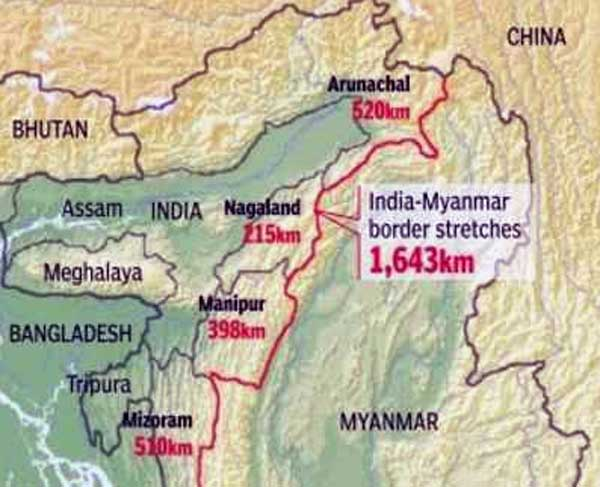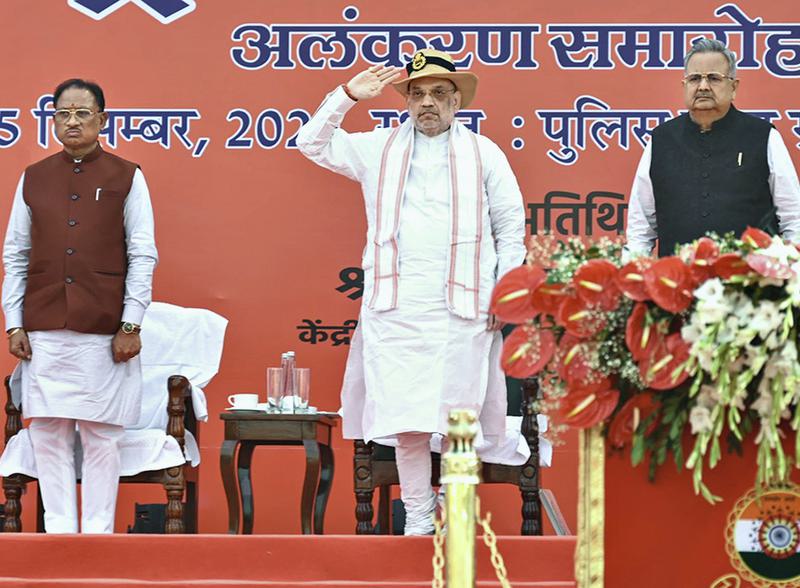Free Movement Regime

- 27 Dec 2024
In News:
The Indian government, through the Ministry of Home Affairs (MHA), has recently issued new guidelines to regulate the movement of people between India and Myanmar, especially along the border regions. These guidelines come after the suspension of the Free Movement Regime (FMR), which had previously allowed residents within a specified range of the border to move freely. The new protocol aims to enhance internal security and address concerns related to demographic shifts in India's northeastern states.
Background of the Free Movement Regime (FMR)
What is FMR?
The Free Movement Regime (FMR) is a bilateral arrangement between India and Myanmar that permits residents living in border areas to cross the international boundary without a visa. This agreement was established in 1968 to facilitate familial, cultural, and economic exchanges between people living on either side of the border.
Territorial Limits and Evolution
Initially, the FMR allowed free movement within a 40 km radius from the border. However, in 2004, this limit was reduced to 16 km, and additional regulations were introduced in 2016. The most recent development sees the limit further reduced to 10 km, with stricter regulations implemented to regulate the movement.
Recent Developments and New Guidelines
Suspension of FMR
In February 2023, Union Home Minister Amit Shah announced the suspension of the FMR along the India-Myanmar border, citing concerns about internal security and demographic changes, particularly in India's northeastern states. This decision came in the context of growing ethnic violence and political pressures, especially from states like Manipur.
Despite the announcement, the formal scrapping of the FMR is yet to be officially notified by the Ministry of External Affairs (MEA). However, the MHA has issued new guidelines to regulate cross-border movement, focusing on enhancing security without completely discontinuing the regime.
Key Features of the New Guidelines
The updated protocols issued by the MHA include several measures aimed at improving the security and regulation of movement across the border:
- Reduced Movement Limit: The new guidelines reduce the free movement limit from 16 km to 10 km from the border on both sides.
- Border Pass System: Residents wishing to cross into Myanmar or return to India must obtain a "border pass" from the Assam Rifles. This pass allows a stay of up to seven days in the neighboring country.
- Document and Health Checks: Upon entry into India, individuals will undergo a document inspection by the Assam Rifles, followed by security and health checks conducted by state police and health authorities. Biometrics and photographs will be collected, and a QR code-enabled border pass will be issued for verification.
- Designated Entry Points: There will be 43 designated entry and exit points across the border, with biometric verification and health screening required at all points.
- Monitoring and Enforcement: The Assam Rifles will oversee the movement, ensuring that individuals comply with the new regulations. Violations of the movement protocol will result in legal action.
Infrastructure and Technology Implementation
The government plans to establish infrastructure, such as biometric machines and software for border pass issuance. Pilot entry and exit points will be operational soon, with a phased implementation for the remaining points.
Political Reactions and Opposition
Regional Concerns and Opposition
The suspension of the FMR has been a contentious issue in India's northeastern states. The governments of Nagaland and Mizoram have raised objections to the scrapping of the regime, citing the cultural and familial ties of border communities. The Nagaland Assembly passed a resolution opposing the government's decision, while political leaders in Manipur argued that the unregulated movement of people had contributed to ethnic violence in the region.
Specific Concerns in Manipur
The chief minister of Manipur, N. Biren Singh, attributed ongoing ethnic conflicts in the state to the unchecked movement of people across the border. This was particularly evident in the violent ethnic clashes that broke out in 2023. As a result, Singh urged the Home Ministry to cancel the FMR along the India-Myanmar border, and the new guidelines reflect the state's concerns.
Conclusion
The suspension of the Free Movement Regime along the India-Myanmar border, followed by the introduction of stricter guidelines, marks a significant shift in India's border management policy. While the formal scrapping of FMR is yet to occur, the new protocols aim to balance security concerns with the region's long-standing cultural ties. The implementation of biometric checks and designated entry points signifies the government’s focus on modernizing border control while addressing regional concerns. The outcome of this policy shift will have important implications for internal security, demographic dynamics, and bilateral relations between India and Myanmar.
Commitment to Eradicating Naxalism in Chhattisgarh by 2026

- 17 Dec 2024
Overview
Union Home Minister Amit Shah has reiterated India's commitment to eliminate Naxalism in Chhattisgarh by March 31, 2026. He emphasized the progress made in the fight against Naxalism, highlighting key successes and outlining the strategy for the coming years.
Key Pointers
- Government Commitment: Amit Shah emphasized the joint commitment of the Government of India and the Chhattisgarh state leadership to rid the state of Naxalism by 2026.
- Security Forces’ Success: Over the past year, Chhattisgarh police neutralized 287 Naxalites, arrested around 1,000, and saw 837 surrenders.
- Top Naxal Cadres Neutralized: The state forces successfully neutralized 14 high-ranking Naxal cadres.
- President’s Police Colour Award: Chhattisgarh Police received the President's insignia within 25 years, a significant achievement for the state.
The Three-Pronged Strategy for Eliminating Maoist Insurgency
- Security Measures (Force)
Deployment of Security Forces
- Enhanced Presence: Increased deployment of Central and State police forces in Left-Wing Extremism (LWE) areas.
- Joint Operations: Coordinated operations between state and central forces, including CRPF and COBRA units.
- Upgraded Technology: Incorporation of UAVs, solar lights, and mobile towers to enhance operational efficiency.
Operation SAMADHAN
- Key Elements:
- Smart Leadership: Leading with innovative strategies.
- Aggressive Strategy: Swift, decisive action against insurgents.
- Motivation and Training: Strengthening the capabilities of forces.
- Actionable Intelligence: Real-time intelligence for effective operations.
- Harnessing Technology: Using modern tech for strategic advantage.
2. Development Initiatives
Focused Development Schemes
- PMGSY: Rural road connectivity under the Pradhan Mantri Gram Sadak Yojana.
- Aspirational Districts Program: Improving infrastructure in Naxal-affected areas.
- Skill Development: Targeted schemes in 47 LWE-affected districts to reduce unemployment.
Infrastructure Development
- Special Infrastructure Schemes: Building schools, roads, and bridges in remote areas to integrate them into the mainstream economy.
- Rehabilitation: Focus on providing rehabilitation for former Naxals through education and vocational training.
3. Empowerment (Winning Hearts and Minds)
Public Engagement
- Tribal Empowerment: Strengthening communication with tribal communities to reduce alienation and mistrust.
- Rehabilitation Policies: Surrender schemes offering incentives like education and financial aid to reintegrate former insurgents into society.
Maoism: Ideology and Background
What is Maoism?
- Origin: A form of communism developed by Mao Tse Tung, focusing on armed insurgency to capture state power.
- Core Beliefs: Maoists believe in violence and insurrection as legitimate means to overthrow the state and establish a People’s Democratic Republic.
- Indian Maoism: The Communist Party of India (Maoist), formed in 2004, leads the largest Maoist insurgency in India.
Recent Achievements in Combatting Maoist Insurgency
Key Successes in 2023
- Maoist-Free Villages: Villages in Dantewada declared "Maoist-free," a significant victory for the state.
- Reduction in Security Forces’ Casualties: 14 deaths in 2024, a dramatic decrease from 198 deaths in 2007.
- Infrastructure and Logistical Support: Enhanced use of helicopters and fortified police stations.
Government’s Commitment to Rebuilding
- Rehabilitation and Welfare: The government is implementing policies to improve the living standards of affected families, including 15,000 houses for Naxal-affected regions.
- Economic Development: Focus on building infrastructure and providing employment through skills training programs.
Challenges in Eliminating Naxalism
Socio-Economic Issues
- Exploitation of Tribals: Marginalization of tribals due to displacement for mining and forestry.
- Lack of Infrastructure: Basic amenities like roads, schools, and healthcare are absent in many areas.
- Centralized Naxal Command: The CPI (Maoist) retains a strong leadership, despite fragmentation of its forces.
Governance and Trust Issues
- Alienation of Local Populations: Ineffective governance and poor implementation of welfare schemes fuel local support for Naxal groups.
- Resource Conflict: The Naxals exploit rich mineral resources in the region to fund their insurgency.
Way Forward
Governance and Economic Reforms
- Tribal Empowerment: Form Tribal Advisory Councils as per the Fifth Schedule for better resource management.
- Land Redistribution: Enforce the Land Ceiling Act to reduce inequality.
- Livelihood Programs: Offer alternative livelihoods to reduce dependency on illegal activities.
Security Measures
- Paramilitary Deployment: Specialized forces to secure tribal areas and enable local governance.
- Resource Management: Ensure sustainable exploitation of natural resources, involving tribal communities in the decision-making process.
Peace Dialogues
- Inclusive Policies: Engage in dialogue with Naxals to facilitate their reintegration into mainstream society.
Conclusion
Naxalism in India, particularly in Chhattisgarh, is a complex issue rooted in socio-economic inequalities, lack of development, and historical alienation of tribal communities. The government's approach, encapsulated in the SAMADHAN strategy, combines security operations with developmental initiatives and a focus on empowerment to tackle the problem. With a clear commitment to eliminate Naxalism by 2026, the Indian government is making significant strides in reducing violence, improving governance, and integrating affected communities into the mainstream.
Beware of Digital Wedding Invites

- 08 Dec 2024
In News:
In the peak wedding season, cyber fraudsters are increasingly exploiting digital wedding invitations to hack into mobile phones. These fraudulent invites, often disguised as PDF wedding cards shared on WhatsApp, contain embedded malware that allows cybercriminals to gain full access to the victim's phone. This includes access to sensitive financial data, making individuals vulnerable to fraud. The Lucknow Police Cyber Cell has issued a public warning, urging citizens to be cautious and avoid opening suspicious files.
How the Scam Works
The scam involves cybercriminals sending out malware-laden wedding invitations. Once the recipient opens the file, the malware infects their phone, enabling the fraudsters to remotely control the device. From there, they can access sensitive information, including bank account details, and may even transfer funds without the victim’s consent.
Preventive Measures and Cyber Hygiene
To protect against such scams, individuals should follow these preventive steps:
- Avoid Suspicious Files: Do not open files from unknown senders, particularly those with extensions like APK, PIF, or VBS. It is crucial to verify the sender's number—legitimate Indian numbers typically begin with +91.
- Turn Off Auto-Download: Disabling automatic downloads on platforms like WhatsApp can prevent files from being opened unknowingly.
- Enable Two-Step Verification: Strengthen security by activating two-step verification on your digital accounts and setting strong passwords.
- Report Fraud Immediately: In case of suspicious activity, contact the cybercrime helpline at 1930 or file a complaint on the official cybercrime portal (www.cybercrime.gov.in).
The Lucknow Police’s “Cyber Pathshala” campaign aims to raise awareness and educate the public on digital scams, particularly during the wedding season when these frauds are at their peak.
Cybersecurity Challenges in India
This emerging digital threat is part of a broader trend of sophisticated cybercrimes in India. Cyber fraudsters are increasingly using manipulative tactics, such as phishing, fake digital arrests, and malware attacks. In 2024, India witnessed a significant rise in ransomware attacks, frauds targeting financial institutions, and supply chain vulnerabilities.
India's legislative and institutional frameworks are evolving to address these challenges. Key measures include:
- The Information Technology Act, 2000, which lays the foundation for tackling cybercrimes.
- The Digital Personal Data Protection Act, 2023, which focuses on protecting personal data.
- The Indian Computer Emergency Response Team (CERT-In), which coordinates national responses to cyber incidents.
Additionally, new frameworks like the National Cyber Security Policy, 2013, and initiatives such as Cyber Surakshit Bharat and the Indian Cyber Crime Coordination Centre (I4C), aim to fortify India's digital landscape and promote cybersecurity.
Emerging Cyber Threats
As India becomes more digitally connected, the threat landscape continues to evolve:
- Digital Arrest Scams: Fraudsters impersonate law enforcement to extort money from victims, claiming they are under investigation for fictitious crimes.
- Ransomware: Attacks on critical infrastructure, such as financial institutions and healthcare systems, have led to operational disruptions and financial losses.
- Deepfake Technology: The rise of AI-generated deepfakes poses significant risks, including misinformation and financial fraud.
- Internet of Things (IoT) Vulnerabilities: The rapid adoption of IoT devices has created new security challenges, with many devices lacking adequate protection.
Strategic Recommendations for Enhancing Cybersecurity
To counter these evolving threats, India must focus on several strategic areas:
- Digital Literacy Campaigns: Nationwide efforts to improve digital literacy, particularly targeting vulnerable groups such as rural populations and senior citizens.
- Stronger IoT Security Protocols: Mandating secure design and certification for IoT devices.
- AI-Driven Threat Intelligence: Implementing AI-based tools for early threat detection and response in critical sectors.
- Mandatory Cybersecurity Audits: Regular audits of critical infrastructure, especially in sectors like healthcare, banking, and utilities.
- Public-Private Collaboration: Strengthening partnerships to address challenges such as cryptocurrency fraud, ransomware, and dark web-enabled crimes.
Conclusion
The rise of digital fraud, including the manipulation of wedding invitations for malicious purposes, highlights the need for enhanced cybersecurity measures in India. By improving public awareness, investing in technological solutions, and reinforcing legal and institutional frameworks, India can better protect its citizens from the growing threat of cybercrime. A proactive and informed approach is essential to secure the digital future of the nation.
Current Representation of Women in CAPFs

- 04 Dec 2024
In News:
The Central Armed Police Forces (CAPFs) of India, comprising forces like CRPF, BSF, CISF, and others, play a crucial role in maintaining internal security. Women’s participation in these forces has been historically limited, but recent efforts have focused on increasing their representation. As of 2024, women constitute only 4.4% of the total personnel in CAPFs, highlighting the slow progress despite various initiatives.
Current Representation and Changes Over Time
- Overall Representation: Women make up 4.4% of the 9.48 lakh-strong CAPFs. Within this, the Central Industrial Security Force (CISF) has the highest representation at 7.02%, followed by the Sashastra Seema Bal (SSB) at 4.43%, Border Security Force (BSF) at 4.41%, Indo-Tibetan Border Police (ITBP) at 4.05%, Assam Rifles at 4.01%, and Central Reserve Police Force (CRPF) at 3.38%.
- Growth of Women Personnel: From 15,499 women in 2014, the number has tripled to 42,190 in 2024, reflecting a steady increase in recruitment. However, the percentage remains low despite these gains.
- Recruitment Trends: In 2024, 835 women were recruited, with 5,469 more in the process. In 2025, 4,138 women are expected to be recruited.
Government Efforts and Parliamentary Committee Recommendations
- Policy Measures: The government has introduced several steps to encourage women’s participation in CAPFs, such as reservations in constable-level positions: one-third for CRPF and CISF, and 14-15% for border forces like BSF, SSB, and ITBP.
- Challenges in Recruitment: Despite these policies, recruitment has not kept pace with the targets. The 2022 Parliamentary Committee on Home Affairs expressed disappointment over the “abysmally low” number of women in CAPFs, noting that women made up only 3.68% of the forces at that time.
- Recommendations by Parliamentary Committees:
- The Home Affairs Committee recommended fast-tracking phase-wise recruitment of women, particularly in CISF and CRPF.
- The Standing Committee on Personnel (2023) suggested “soft postings” for women to avoid difficult working conditions, especially in remote or strenuous terrains. It also called for reservations for transgender individuals.
- In 2024, further steps like fee waivers, relaxed physical standards, and provisions for maternity and child care leave were introduced to make the work environment more inclusive.
Reasons Behind Low Representation
- Cultural Barriers: Traditional gender roles and societal expectations deter many women from pursuing careers in security forces.
- Work Environment: The demanding nature of the job, which includes postings in remote areas and high-risk operations, makes it less appealing, especially for women with family responsibilities.
- Infrastructure Issues: Lack of adequate accommodation, sanitation facilities, and safety measures for women are deterrents to joining and retaining female personnel.
Conclusion and Future Outlook
Although the representation of women in CAPFs has seen improvement, it remains below expectations due to persistent challenges. The government’s continuous focus on recruitment reforms, better working conditions, and policy incentives will be crucial to achieve gender parity in these forces. As societal attitudes evolve and the infrastructure improves, more women may be encouraged to serve in these vital security roles. Future efforts must include targeted recruitment drives and creating a more inclusive and supportive environment to enhance women’s participation in CAPFs.
Digital Arrests

- 01 Dec 2024
In News:
In 2024, India has witnessed an alarming rise in cybercrime, particularly a new scam called "digital arrests." This type of fraud involves criminals impersonating law enforcement officials to extort money from victims. With more than 92,000 people targeted and ?2,141 crore defrauded from victims, these scams are rapidly becoming a significant concern for the public and law enforcement.
Nature of ‘Digital Arrests’
The modus operandi of digital arrest scams is sophisticated and emotionally manipulative. Cybercriminals contact victims through video calls, often using fake police officers' profiles and official documents to build credibility. They accuse victims of serious crimes such as money laundering or drug trafficking, claiming urgent action is needed to avoid arrest. The scammers create a false atmosphere of fear and urgency, convincing the victim to transfer large sums of money under the pretext of settling legal dues.
A notable example involves Ruchi Garg, who was targeted by scammers posing as police officers, falsely claiming her son was involved in a major scam. She was coerced into transferring ?80,000 before realizing it was a scam. Similar cases have affected hundreds, with perpetrators using AI-generated voices and fake visuals to amplify the deception.
The Growth of Cybercrime in India
Digital arrest scams are part of a broader increase in cybercrime in India. The Indian Cyber Crime Coordination Centre (I4C) has reported a rise in cyber fraud, with financial losses exceeding ?27,900 crore between 2021 and 2024. The most significant sources of these losses include stock trading scams, Ponzi schemes, and digital arrest frauds. As criminals adapt to emerging technologies and use social engineering tactics, the scale and complexity of scams are growing.
The surge in cybercrimes is fueled by vulnerabilities in India's digital landscape. With over 95 crore Internet users, many people, particularly the elderly or less tech-savvy, remain susceptible to such fraud. Cybercriminals often exploit this lack of awareness, combining fear and confusion to manipulate victims.
International Scope and Challenges
One of the challenges in combating digital arrests is the transnational nature of cybercrime. Scams often originate from countries like China, Cambodia, and Myanmar, where "scam compounds" run operations to train individuals in fraudulent techniques. These groups use virtual private networks (VPNs) and encrypted apps to conceal their identities and locations, making it difficult for Indian authorities to trace them.
Moreover, the involvement of mule bank accounts to launder defrauded money complicates investigations. Thousands of such accounts are identified and blocked regularly, but the flow of money continues through multiple channels, including cryptocurrencies.
Government Efforts and Preventive Measures
To address the growing menace of digital frauds, the Indian government has initiated several measures. The I4C, launched in 2020, aims to strengthen the response to cybercrimes by coordinating with various law enforcement agencies. The National Cyber Crime Reporting Portal allows citizens to report cyber fraud, while real-time alerts are sent to banks to prevent financial losses.
Additionally, the Cyber Crime Coordination Centre and other initiatives like Cyber Surakshit Bharat and CERT-In are working to enhance cybersecurity awareness and support victims. The Digital Personal Data Protection Act, 2023, also aims to regulate data security, which can reduce the sale of personal data on the dark web, a key enabler of these scams.
Conclusion
‘Digital arrests’ exemplify the evolving nature of cybercrimes in India. As digital threats become more complex and widespread, it is essential for citizens to remain vigilant and informed. Effective law enforcement, technological innovations, and public awareness are critical to reducing the impact of these scams and safeguarding the digital economy.
